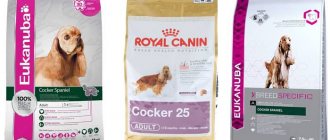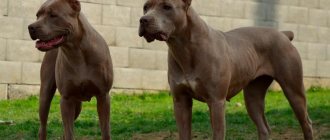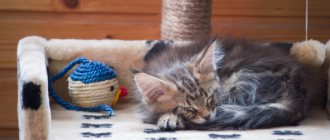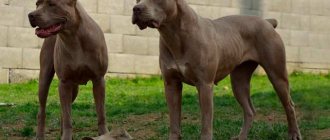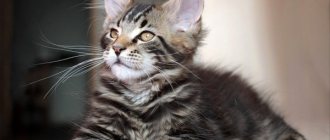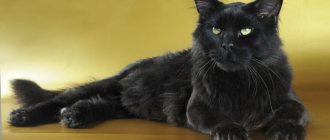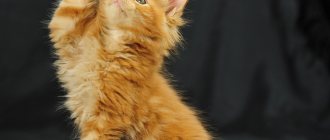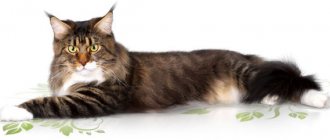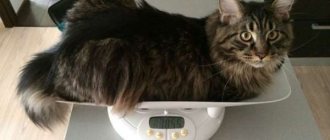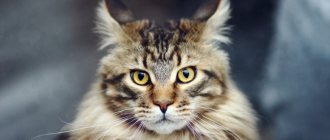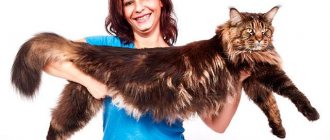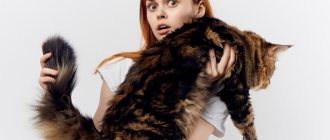The Maine Coon is a native cat breed that originated in the United States. Its development and formation took place mostly in Europe, where breeders and breeders developed new lines of animals, securing in them certain character traits and external characteristics inherent in modern Maine Coons. This led to the emergence of two intrabreed varieties: American and European.
What are Maine Coons: types of breed
Despite the fact that the first Maine Coons appeared in the United States, European breeders took part in the development of the breed. Thus, certain breed characteristics inherent in modern representatives were fixed. This was the reason for the appearance of two types of Maine Coons: American and European. Representatives of these subspecies differ from each other in breed characteristics and character. What types of Maine Coons are there, read below.
Description of the American type breed standard
There is an opinion that the Maine Coon is a hybrid of the Manx raccoon and a domestic cat. Genetically this is unlikely, but cats have some similarities with wild raccoons.
The main breed characteristics of the American Maine Coon type:
- Long body and large bones;
- Wide variety of colors. Only chocolate, ticked and point colors are prohibited for breeding, which may indicate interbreeding;
- Thick fur in the collar and panties area. Nature invented this feature to protect cats from the harsh North American climate;
- Fluffy and long tail.
Aboriginal representatives of the breed are distinguished by good health.
Description of American type standard:
- Body: large, rectangular with a wide chest;
- Paws: medium length, round, muscular;
- Tail: long, wide at the base, tapering towards the tip;
- Coat: thick, long, close to the body, waterproof;
- Eyes: wide-set, slanted. The color should look harmonious with the color;
- Head: massive, square. The skull is powerful, the cheekbones are high. The chin, nose and upper jaw form one line;
- Ears: Large, with a wide base, tapering to the tips. The distance between the ears is equal to the width of the base of one ear. A characteristic feature is the presence of tassels;
History of selection and features of the European cat variety
European breeders decided to create an “extreme” breed of cats, based on aboriginal cats. But, despite the efforts of breeders, the European type of Maine Coon has its own mutations, due to which these cats differ from the classical standards.
European look
The appearance of European Maine Coons in the 70s of the 20th century led to the formation of a separate type of representatives of this breed. European cats have significant differences from the aborigines - the work of breeders to consolidate certain traits in their pets provoked their distance from the original type and the manifestation of extreme traits. The goal of the breeders is to achieve maximum difference from the American type, this determines the main characteristics of the “Europeans”:
- long body;
- elongated, tapered muzzle;
- low forehead;
- long ears with tassels;
- high paws;
- long tail reaching to the shoulder.
An important difference between Maine Coons of the European type is their slanted eyes, the shape of which makes the look of these cats predatory and gives them a proud look. “Europeans” do not have such a thick and silky coat as the aborigines, but their beautiful solid smoky color makes them popular among cat lovers.
At the beginning of the selection breeds, “Europeans” were distinguished by fragility and excessive grace, but over time this problem was solved.
How to distinguish an American Maine Coon from a European one
It is difficult for the average person to distinguish one type of coon from another. But, there are some features by which you can determine which branch the animal belongs to. Here are the main ones:
- “Americans” have a shorter torso than “Europeans”. But, their physique is denser.
- Aborigines are endowed with smaller ears than “extreme” people;
- The American Maine Coon has a more powerful chin and a curved profile;
- The look is kinder than that of a European;
- If you see a Maine Coon of tabby color, it means that he is American.
It follows from this that the indigenous breed is a classic, and the Europeans are a modern breed.
How to choose a kitten
You must immediately decide for what purpose you are taking a kitten: for breeding or as a pet. The amount you will have to spend on the purchase depends on this.
All kittens are divided into three classes: pet, breed and show.
Pet class - do not participate in breeding. These are pets. As a rule, these animals have slight deviations from breed standards. But their price is much lower.
Breeding and show class kittens are purchased for participation in exhibitions and breeding. These coonlets are as close as possible to the breed standards.
All Maine Coon kittens are cute and cheerful. If you want a pet, you shouldn't spend all your savings on a show-class animal. Choose the one you like and who has enough money.
You need to decide whether you need a girl or a boy. Maine Coon cats are more affectionate and cunning. Males are straightforward in character and much larger in size than girls. Their weight can reach up to 10 kg. The weight of females is 2-3 kg less.
To purchase a kitten, contact a special breed nursery.
Before you make a purchase, check with. All Maine Coon kittens born from purebred parents must have documents, regardless of class. Pets are no exception. A negative answer is a reason to be wary. Perhaps they are trying to sell you a mestizo.
When visiting a cattery, familiarize yourself with the conditions in which the cats live. They should not be kept in cages. The room must be clean.
Pay attention to the condition of the animals. It's a bad sign if they are exhausted.
Before choosing a Maine Coon kitten, meet its parents. This will give you an idea of how your pet will grow up.
Ask the breeder any questions you want answered. The specialist will tell you everything about Maine Coons.
If the nursery is trustworthy, mom and dad like it, we choose a pet.
- The kitten should be moderately well-fed. Not fat. Not skinny.
- Check the condition of your eyes and nose. The mucous membranes must be clean.
- Play with your baby. Look how he runs and jumps. You will see how he moves. This will eliminate problems with joints and bones. A healthy baby is always active, mobile, and will not refuse to play.
- A good Maine Coon kitten should have large bones, massive paws, and a long body. As for the tassels on the ears, they are not required, but desirable. If the tassels have not appeared by two months, they will not appear again. What is more important is not the presence of tassels, but the correct placement of the ears. They should be large, vertical, set high.
- At three months, a Maine Coon kitten is the same size as an ordinary barn cat.
Its weight is at least one and a half kilograms. The minimum weight of a Maine Coon kitten can be calculated using the formula: the number of months is multiplied by 0.5 kg. At five months the kitten will have a minimum weight of 2.5 kg, at 6 months - 3 kg.
At what age should you take a kitten home?
You can take your baby home at the age of 12 weeks. You shouldn't do this before. The kitten must learn to eat food received in the nursery and use the litter box. He must receive the necessary vaccinations.
In addition, the breed characteristics of a kitten at the age of one month cannot be assessed. Even a professional cannot cope with this task.
If you liked a very small kitten from the nursery, leave a deposit for it. When he grows up, take him.
The character of the “American” and the “European”
Maine Coons are cats and dogs. Unlike other breeds, they love to spend time with their owner, bathe, and carry objects in their teeth.
Representatives of both branches, despite their attachment to the owner, value their independence. They love affection, but cannot stand intrusiveness. Constant squeezing is not for them. When guests come to the house, these cats can play, but they will not get into your hands.
Coons are quite active cats. They love to run and jump, so they require a separate play area in the house. Peak activity is morning and evening. They spend the day on the couch. American representatives of the breed love to play with balls and toy mice, as they are hunters by nature. “Europeans” love to lie on the sofa and have their tummy scratched.
gulliver cat
The pros and cons of the breed are closely interrelated. The disadvantages of the breed largely appeared with the departure from the wild and careful selection by man. The prototypes of the breed are cats that lived on US farms in the 19th century. In the official history of the Maine breed, the animals are described as large and strong. Their features - tassels on the tips of the ears and between the pads of the fingers, a fluffy tail and huge eyes - are still carefully preserved by breeders.
But as it merged with civilization, the animal became more vulnerable, lost its natural immunity and became more susceptible to various diseases.
Today's Maine cats have forgotten how to catch mice. Menacing in appearance, they have an affectionate character. Maine Coons most often live in apartments, where their main function is to be a companion for humans. This significantly affected their weight - the normal weight for a cat is 7-12 kg, and cats can gain from 6 to 9 kg in adulthood.
Increased weight often leads to an increased likelihood of injury and a longer gestation period. It is now considered normal for a Maine cat to lamb during a gestation period of up to 72 days. For comparison, in other breeds pregnancy is allowed up to 65 days.
How to care for representatives of both types of Maine Coons
In terms of care, the Maine Coon is a difficult breed. To keep your pet healthy and happy for a long time, you must follow the following rules:
- Feed only high-quality food or natural food. There are special foods in the Royal Canin or Brit line, developed specifically for this breed. For those owners who prefer natural food, you need to understand that 80% of a cat’s diet consists of meat and meat by-products.
- To prevent your pet from getting sick, it is necessary to vaccinate once a year.
- Long and thick hair requires constant care with special combs and shampoo.
- You need to bathe your cat once a month. If your pet goes outside, it needs to be regularly treated for fleas and other parasites.
- For healthy fur, teeth and claws, your pet needs vitamins. The best option is to crush it and put it in your mouth—coons don’t like to eat tablets.
Care
Caring for cats is labor-intensive. Requires a lot of time and effort. The reward is a happy, beautiful and loving pet.
Check your ears and eyes regularly. If dirt and wax have accumulated in your ears, remove them with a cotton swab soaked in a special lotion.
The cat's eyes should be clear. If there is discharge in them, remove them with a special napkin. If there is none, use a swab moistened with boiled water or eye lotion. It is not recommended to use chamomile infusion. It has a bad effect on the hair around the eyes.
Wool
A kitten must be taught to care for its fur literally from the first days it arrives in the house. If you don't do this, he won't like handling the comb later. He will resist and may show aggression.
Starting from six months, kittens' coats change. The baby's undercoat falls out. The fur becomes thick and tough. To make this period pass faster, the animal must be combed at least twice a week.
In addition, during this period the pet’s body especially needs vitamins and microelements. If there are not enough of them, the period of baby molting will drag on for a long time. The appearance of the coat will deteriorate.
An adult animal sheds twice a year - in spring and autumn. For cats that live in apartments, their schedule is often disrupted. Shedding may occur earlier or later and may take longer.
In addition to seasonal molting, the coat is constantly renewed. Experts say that each hair on a Maine Coon “lives” for about a month and then falls out.
Regular brushing will help maintain the beauty of the coat and prevent the formation of tangles. Makes it easier to maintain cleanliness in the apartment.
If the cat is not brushed, he will lick the fur off himself. As a result, it will accumulate in the intestines, which can lead to health problems.
How to brush a Maine Coon
This must be done in several stages.
First, comb the animal with a wide-toothed comb. This will allow you to identify problem areas.
Most often, hair rolls up behind the ears, on the stomach, chest, lower neck, and hind legs.
Carefully remove any tangles found with your hands. Try combing. If that doesn't work, cut them out with scissors.
After this, comb the coat with a fine-toothed comb. This will remove the undercoat and “outdated” hairs.
Bathing
Maine Coons love water. If babies are introduced to water baths from an early age, they will begin to enjoy the procedure.
You need to bathe your cat in warm water – 35 degrees. Place a rubber mat or towel on the bottom of the bath to prevent your pet from slipping and falling. Make sure that water does not get into your pet's ears.
Maine Coons need to be washed with special shampoos for long-haired cats. Then rinse with water.
Upon completion of the procedure, the animal should be dipped in a soft towel. If you rub too hard, the fur may become tangled.
After the bath, make sure that the cat does not get caught in a draft and catch a cold. To prevent this from happening, dry the fur coat a little with a hairdryer. Then let the cat finish the job himself - lick the fur.
Nail care
Cats themselves monitor the length of their claws. If necessary, grind them off or bite off the ends. However, the owner must keep this process under control.
Maine Coons need to sharpen their claws. To prevent cats from damaging the furniture in the apartment, it is necessary to install special scratching posts. If they are not there, then there is a high probability that upholstered furniture or door jambs will be damaged. Claw grinders must be well secured so that a large cat cannot turn it over or drop it on the floor.
It must be borne in mind that even if a pet uses a scratching post, this does not guarantee that he will put his claws in order on his own. It is necessary to control the length of your pet's claws, otherwise they will cause discomfort and problems for the raccoon cat.
The claws on the front paws are always longer than those on the hind paws.
If the claws are very long and cause discomfort to the pet, they need to be trimmed a little. This can be done at a pet salon, veterinary clinic, or invite a specialist.
The owner can trim the pet's claws himself. However, inexperienced people should not undertake this procedure. The claw contains blood vessels. If they are damaged, severe bleeding will occur.
Particular attention should be paid to the fifth toes on the front paws. These fingers do not come into contact with the ground or floor. Long claws grow on them and begin to bend at the end. Sometimes it grows into the skin. The pet is in severe pain. To prevent this from happening, the claws need to be trimmed on time.
If a cat breaks a claw while playing, its sharp tip must be trimmed. Otherwise, a fragment of the claw will damage the animal's paw. The wound must be treated with an antiseptic.
What to feed
The cat must be fed food prepared especially for it. Food from the owner's table is harmful to the pet. This is due to the characteristics of the animal’s digestive system, which differs from the human one. Food from the owner's table is poorly digested and can cause a number of diseases.
There are two options for feeding the animal:
- natural,
- industrial feed.
You can choose a natural diet for your pet only if you have the time to cook especially for him.
Foods that are good for Maine Coons
- Lean meat: horse meat, beef, lamb, rabbit, turkey, chicken.
- Offal: heart, tripe, liver.
- Vegetables: carrots, pumpkin, zucchini, cauliflower. They can
- Greens: parsley, dill, lettuce.
- Cereals: oatmeal, rice, buckwheat.
- Sea fish: hake, pollock, pink salmon.
- Chicken and quail eggs.
- Fermented milk products: cottage cheese, kefir, yogurt, Varenets.
- Vegetable oil. It should be added to vegetables and cereals 1⁄2 teaspoon. Sunflower, olive, flaxseed are suitable.
Forbidden food
- Fat meat. Causes disruption of the digestive system. Frequent use can lead to the death of the animal.
- Bones. Can injure the gastrointestinal tract.
- Milk. Causes indigestion.
- Beans. Lead to bloating and flatulence.
- Noodles. Buns and pies. Provokes gastrointestinal colic, bloating and diarrhea.
- You should not feed your cat salty food. Because of it, the risk of cardiovascular diseases increases.
An adult Maine Coon should be fed 2 times a day. To do this, the daily food intake should be divided into two meals.
The cat should always have access to a cup of clean water
If you don’t have time to prepare food for your cat, commercial food will help get out of the situation. Choose a product from one of three classes:
- premium;
- super premium;
- holistic.
Depending on the consistency, industrial feeds are divided into 2 types: dry and wet.
Each has its own advantages and disadvantages.
Dry food can remain in a cat's bowl for 24 hours. There is no moisture in it. When using it, your pet must be provided with access to clean and fresh water.
Wet food is available in the form of jellies and pates. It is well absorbed by the cat's body. It is not only nutritious, but also high in calories. Pets love him. If it is abused, the coon may become overweight.
You can combine dry food with wet food. In this case, dry food should account for 75% of the daily ration, respectively wet food - 25%.
Food for a Maine Coon should be selected taking into account age, health status and energy costs. It is important to follow the dosage specified by the manufacturer.
Cons of the breed
Maine Coons generously give positive emotions. Their mischievous nature and funny habits can be the subject of colorful conversations with friends and family. Maine cats are characterized by a special tact, the reason for which is the developed intelligence of the pet. The disadvantages of the breed are minor compared to the advantages, and they are quite easy to adapt to.
Expensive price
Any purebred cat will cost you a fair amount of money. The price of kunyat depends on the demand for them. The price of a kitten from a titled parent will be significantly higher than others. You should not try to save money by purchasing a pet for your home without a document or a mixed breed, as such actions support unscrupulous breeders.
Healthy! If you dream of a pet Maine Coon, but the high price scares you, then pay attention to pet-class coons, not intended for breeding, or teenage kittens who have been stuck in a nursery without an owner. As a rule, such animals have an affordable price.
Often, breeding kittens does not bring much income to the breeder. Many procedures associated with maintaining a nursery require significant investment:
- food costs for stud cats;
- vaccinations;
- paperwork;
- genetic research;
- maintaining a website, photographing cats and other advertising for the cattery.
Paperwork for a cat is not an empty bureaucratic formality. The felinological community represents the interests of buyers and also monitors compliance with the rules ensuring the maintenance of the health of cats and the purity of the breed. Ignoring the rules when breeding animals leads to the appearance of half-breeds and increases the number of outbred cats.
When buying a purebred kitten, you need to take into account the cost of its further maintenance. The wide range of prices is explained by the different quality of kittens, which can be sold to nurseries as a producer or as a pet. When purchasing, it is better to focus on average prices.
Wool is everywhere
Maine Coons have medium-length fur, which often becomes a problem. This kind of wool can be found everywhere in the house, even in pots of soup. Brushing twice a week will help significantly reduce the size of the disaster. A brush purchased from a nearby pet store is perfect for this purpose, but don’t forget about the latest technology. Engineers have provided cat owners with a useful device - a furminator, the use of which will help significantly reduce the size of the disaster.
Up to 3 years old your Maine Coon is a kitten
Representatives of the Maine breed are very smart and intelligent. At the same time, the kitten’s mind develops up to 3 years and the animal becomes a full adult about two years after puberty. Considering the weight is under 10 kg and great activity, you should exercise maximum caution when leaving a large kitten alone at home. In another case, returning home, you can find great destruction.
Aggressive leader and keen hunter
Maine Coons are confident leaders. If you have other cats or dogs living at home, then the Maine cat will diligently regain its position as leader, using force. Since its size significantly exceeds that of an average cat of another breed, fights and collisions are possible.
When going out of town with your coon, don’t forget to take a harness that will limit your pet’s freedom of movement. The secret passion of any Coon is bird hunting. Awakened hunting instincts can lead to the destruction of nearby bird nests and complaints from neighboring summer residents about missing chickens.
The need for increased nutrition
Due to their size, Maine Coons have an excellent appetite. When purchasing a pet, do not forget to take care of proper nutrition. Maine Coon food should be rich in proteins and minerals to keep the cat's skeletal and muscular systems healthy.
Eating and toilet problems are closely related. A concomitant disadvantage of the breed is its abundant excrement, which also has a rather pungent odor. A properly selected tray, high-quality filler and regular cleaning will help solve the problem.
If you love big cats, then the disadvantages of the breed will seem insignificant to you. Every year the number of lovers of large cats with a delightful fluffy raccoon tail in Russia is increasing.
The Maine Coon is a native cat breed that originated in the United States. Its development and formation took place mostly in Europe, where breeders and breeders developed new lines of animals, securing in them certain character traits and external characteristics inherent in modern Maine Coons. This led to the emergence of two intrabreed varieties: American and European.
